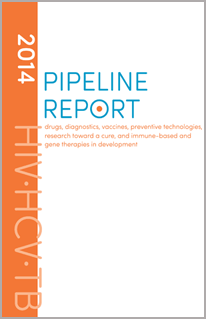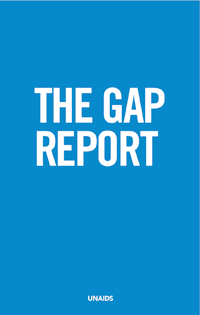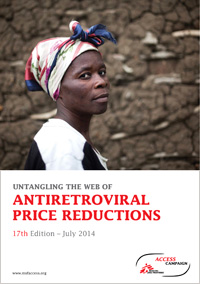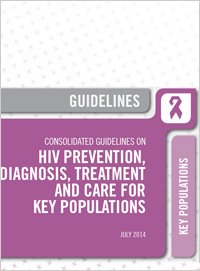Publications launched at AIDS 2014
1 August 2014. Related: Conference reports, World AIDS 20 Melbourne 2014.
Simon Collins, HIV i-Base
A selection of publications launched at AIDS 2014 is included below.
 i-Base/TAG Pipeline Report
i-Base/TAG Pipeline Report
The 264-page 2014 pipeline report was launched on 20 July at the International AIDS Conference in Melbourne.
This annual i-Base/TAG report covers pipleine research into new drugs, diagnostics, prevention, cure and vaccine research for HIV, hepatitis C and TB. It includes a chapter on paediatric ARVs and another on dose optimisation strategies for global health, especially in resource poor settings.
 UNAIDS: The gap report
UNAIDS: The gap report
This 422-page report sets out a strategy for how to close the gap between the people moving forward and the people being left behind?
Similar to the Global report, the goal of the 422-PAGE Gap report is to provide the best possible data, but, in addition, to give information and analysis on the people being left behind.
The report emphasises the importance of diagnosis and treatment as a foundation strategy to end AIDS by 2030. When people find out their HIV positive status they will seek life-saving treatment. In sub-Saharan Africa, almost 90% of people who tested positive for HIV went on to access antiretroviral therapy (ART). Research shows that in sub-Saharan Africa, 76% of people on ART have achieved viral suppression, so they are unlikely to transmit the virus to their sexual partners. New data analysis demonstrates that for every 10% increase in treatment coverage there is a 1% decline in the percentage of new HIV infections.
The report emphasises the importance of location and population through an in-depth regional analysis of HIV epidemics and through analysis of 12 populations at higher risk of HIV. It analyses the reasons for the widening gap between people gaining access to HIV prevention, treatment, care and support, and people being left behind. It shows how focusing on populations that are underserved and at higher risk of HIV will be key to ending the AIDS epidemic.
References:
- UNAIDS. The Gap Report. (July 2014).
http://www.unaids.org/en/media/unaids/contentassets/documents/unaidspublication/2014/UNAIDS_Gap_report_en.pdf (PDF) - UNAIDS. Press statement. UNAIDS report shows that 19 million of the 35 million people living with HIV today do not know that they have the virus. (16 July 2014).
http://www.unaids.org/en/resources/presscentre/pressreleaseandstatementarchive/2014/july/20140716prgapreport - UNAIDS. Press conference video. (16 July 2014).
http://www.unaids.org/en/resources/campaigns/2014/2014gapreport/videofootage
 MSF report: Untangling the web of antiretroviral price reductions (17th edition)
MSF report: Untangling the web of antiretroviral price reductions (17th edition)
Essential reading. This publication from MSF is clearly and concisely written, summarising in less than ten pages of commentary – and this includes photographs – the key factors behind why some people in the world receive HIV treatment and other do not.
Now in its 17th edition, this report has historically compiled information on the global differences in generic prices for all antiretrovirals. For this edition, the information is presented in a new, shorter format focusing on a few key drugs as well as future regimens, along with an analysis of the current opportunities, challenges and threats faced in keeping the price of ARVs down.
http://reliefweb.int/sites/reliefweb.int/files/resources/MSF_UTW_17th_Edition_4_b.pdf (PDF)
MSF report: Getting to undetectable: usage of HIV viral load monitoring in five countries
This brief report is the fifth is a series called “HIV undetectable” that focuses on one of the key differences between management of HIV in high- compared to low-income countries. Access to viral load testing is a cornerstone of routine care in Western countries, but is taking a long-time to become available in all settings.
While lack of viral load testing should not delay or restrict access to ART, the sensitivity it brings to individualising patient care, especially for those people who do not achieve viral suppression on their first combination, makes it an essential tool, along with adherence support, to help as many people on ART as possible to reach and maintain viral suppression.
In an effort to inform policy makers, people living with HIV, and communities about the rapidly changing viral load testing landscape, MSF has issued a number of reports and issue briefs. The reports cover: product information and profiles (including pricing where available); information on the factors influencing costs and steps that can be taken to make viral load tests more affordable; operational strategies to reduce the complexity of monitoring viral load in resource-limited settings; and the policy landscape across countries that are adopting WHO recommendations to implement routine viral load monitoring for people on ART.
Source: Médecins Sans Frontières (MSF): HIV: Undetectable
http://www.msfaccess.org/undetectable
Issue brief 5: Getting to Undetectable: Usage of HIV Viral Load Monitoring in Five Countries (July 2014)
https://www.msfaccess.org/content/issue-brief-getting-undetectable-usage-hiv-viral-load-monitoring-five-countries
Earlier titles in this series are:
- Issue brief 1: Undetectable: How Viral Load Monitoring Can Improve HIV Treatment in Developing Countries
- Issue brief 2: Putting HIV Treatment to the Test
- Issue brief 3: How low can we go?
- Issue brief 4: HIV status? Undetectable
 WHO: Consolidated guidelines on HIV prevention, diagnosis, treatment and care for key populations
WHO: Consolidated guidelines on HIV prevention, diagnosis, treatment and care for key populations
This 170-page report provides evidence-based recommend-ations for men who have sex with men, people who inject drugs, people in prisons and other closed settings, sex workers and transgender people.
These recommendations aim to:
- increase awareness of the key issues and needs
- improve access, coverage and uptake of effective services; and
- increase national and global commitment to funding and services.
The systematic reviews, literature review, values and preferences, supplementary case studies and technical briefs are available as separate appendices.
The document is also notable for a strong recommendation for the option of oral PrEP for MSM and for harm reduction and opioid substitution therapy for people who inject drugs.
Reference:
WHO. Consolidated guidelines on HIV prevention, diagnosis, treatment and care for key populations. Plus additional policy brief and appendices. (July 2014)
http://www.who.int/hiv/pub/guidelines/keypopulations/en/
http://apps.who.int/iris/bitstream/10665/128048/1/9789241507431_eng.pdf?ua=1&ua=1
Lancet on HIV and Sex Workers
This year, the Lancet special theme issue produced to coincide with AIDS 2014 was HIV and sex workers. [1]
Although this is part of a series of HIV-related global health publications, the full contents are unfortunately only available through subscription access.
However, the publication was also the focus of a symposium sessions in the main conference programme, which included presentations for each of the main chapters, and these are available as free access webcasts from the IAS website. [2]
References:
- The Lancet special theme issue on HIV and sex workers. (22 July 2014).
http://www.thelancet.com/series/HIV-and-sex-workers - The Lancet Special Theme Issue on HIV and Sex Workers. Symposia session TUSY04 (22 July 2014). AIDS 2014, Melbourne.
http://pag.aids2014.org/session.aspx?s=2016
